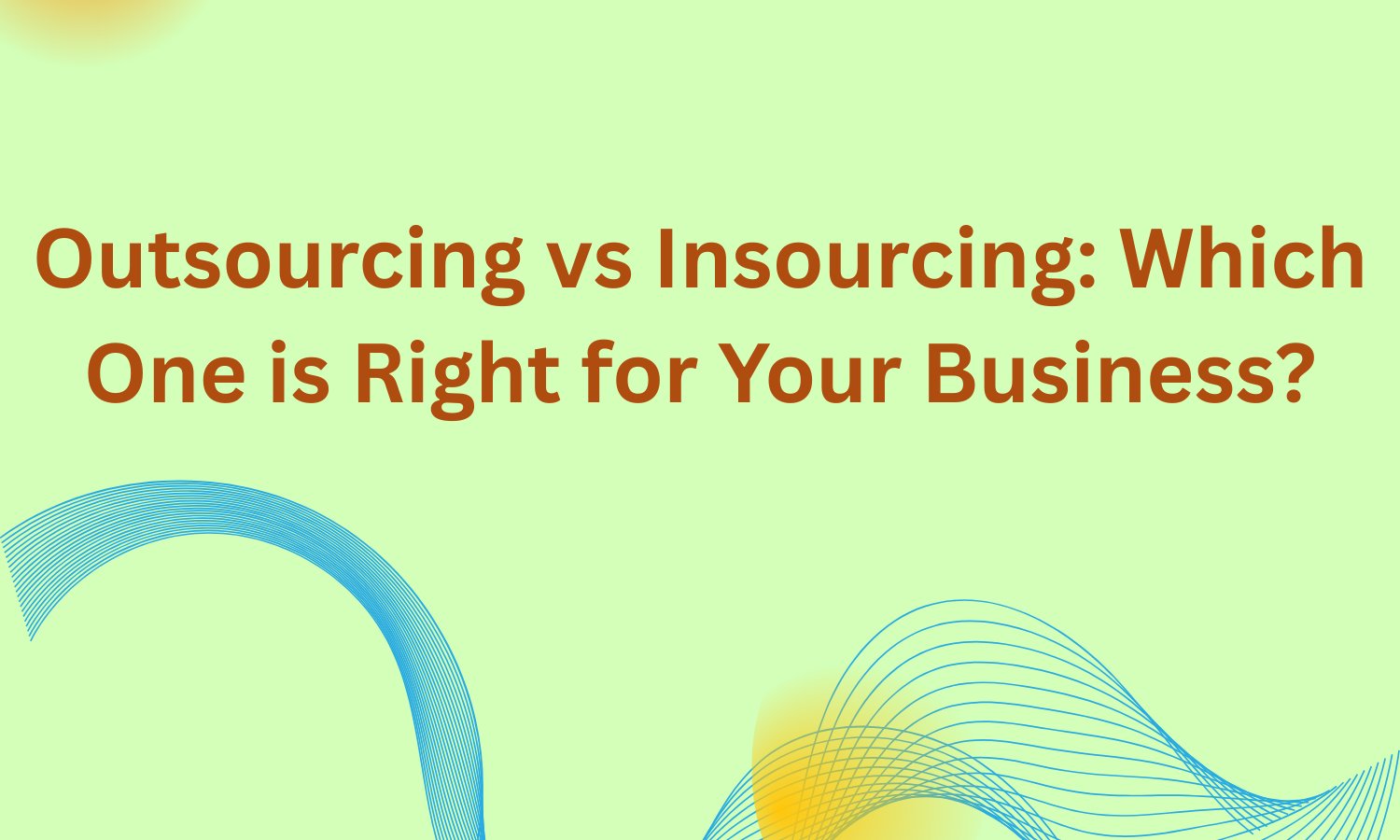Outsourcing vs Insourcing: Which One is Right for Your Business?
By JoeVu, at: April 17, 2023, 7:48 p.m.
Estimated Reading Time: __READING_TIME__ minutes


In today's global business environment, outsourcing and insourcing have become popular strategies for businesses of all sizes. While both approaches offer their own benefits and drawbacks, it's important to carefully evaluate your options to determine which one is right for your business. In this article, we'll take a closer look at outsourcing vs insourcing, exploring their pros and cons, providing examples, and referencing some blog posts for further reading.
1. What is Outsourcing?
Outsourcing is the practice of contracting out work to a third-party provider, often located in another country. This provider is responsible for performing tasks or services that would otherwise be done by in-house employees.
1.1 Pros of Outsourcing
- Cost savings: Outsourcing can offer significant cost savings by reducing labor costs, infrastructure costs, and other expenses related to in-house operations.
- Access to specialized expertise: Outsourcing can provide access to specialized expertise that may not be available in-house, which can lead to better quality work and more efficient operations.
- Increased flexibility: Outsourcing can provide businesses with greater flexibility to scale their operations up or down depending on their needs.
1.2 Cons of Outsourcing
- Lack of control: Outsourcing can lead to a loss of control over business operations, as tasks are being handled by external contractors.
- Communication challenges: Outsourcing can lead to communication challenges due to language barriers, cultural differences, and time zone differences.
- Quality concerns: Outsourcing can lead to quality concerns, as third-party providers may not share the same quality standards as in-house employees.
- Hidden cost: The hidden communication cost of outsourcing includes the time and effort required to manage communication between the in-house team and the outsourced team, which can be exacerbated by language and cultural barriers. This can result in additional time and costs to ensure effective communication and coordination.
- Private data violation: Private data violation in outsourcing refers to situations where sensitive information, such as personal or financial data, is compromised or misused by third-party vendors or contractors. This can occur due to a lack of proper security measures, poor communication between the company and the outsourcing provider, or inadequate vetting of the provider's employees. Private data violation can lead to serious consequences, including financial losses, reputational damage, and legal penalties. As such, it is crucial for companies to carefully consider the risks and take appropriate measures to protect their private data when outsourcing.
1.3 Famous Examples of Outsourcing
Successful Examples
- Apple: Apple outsources the production of its iPhones and iPads to manufacturers in China, such as Foxconn, which has helped the company increase efficiency and reduce costs.
- Nike: Nike outsources the production of its footwear and apparel to manufacturers in Southeast Asia, which has helped the company maintain a competitive edge in the industry.
- IBM: IBM outsources its software development and maintenance to companies in India, which has helped the company reduce costs and improve the quality of its products.
Failed Examples
- Target: Target's decision to outsource its IT operations to a third-party vendor in 2013 led to a massive data breach that compromised the personal and financial data of millions of customers.
- Boeing: Boeing outsourced the production of critical parts for its 787 Dreamliner to suppliers around the world, which led to production delays and quality issues.
- Dell: Dell outsourced its customer support to a third-party vendor in India, which resulted in poor customer service and damaged the company's reputation.
2. What is Insourcing?
Insourcing is the practice of keeping tasks or services in-house that would otherwise be outsourced to a third-party provider. This approach allows businesses to maintain control over their operations and communicate more effectively with their employees.
2.1 Pros of Insourcing
- Better control and communication: Insourcing allows businesses to maintain better control over their operations and communicate more effectively with their employees.
- Protection of sensitive data: Insourcing can provide better protection for sensitive data by keeping it in-house rather than outsourcing it to external contractors or companies.
- Retention of institutional knowledge: Insourcing can help businesses retain institutional knowledge and experience, which can be lost when tasks are outsourced.
2.2 Cons of Insourcing
- Higher labor costs: Insourcing can lead to higher labor costs, as businesses are responsible for paying employee salaries and benefits.
- Limited access to specialized expertise: Insourcing can limit access to specialized expertise that may not be available in-house.
- Reduced flexibility: Insourcing can reduce flexibility in terms of scaling operations up or down depending on business needs.
2.3 Famous Examples of Insourcing
Success Stories
- General Motors: In 2015, General Motors announced it was bringing back most of its IT operations that had previously been outsourced to third-party providers. By bringing these functions in-house, GM was able to better control costs and improve the quality of its IT operations.
- Google: Google has traditionally kept much of its core search and advertising technology in-house rather than outsourcing it to third-party providers. This approach has allowed the company to maintain tight control over its intellectual property and maintain a competitive advantage.
- Netflix: In 2012, Netflix announced it was bringing its DVD-by-mail operation back in-house after previously outsourcing it to third-party providers. By insourcing this function, Netflix was able to improve its customer service and reduce costs.
Failed Stories
- The U.S. Government: The U.S. government has faced numerous challenges with insourcing initiatives, including a lack of skilled workers and the high costs of maintaining in-house operations. For example, the U.S. Department of Defense's insourcing initiative in 2010 resulted in significant cost overruns and failed to achieve the intended savings.
- JPMorgan Chase: In 2015, JPMorgan Chase announced it was bringing some of its IT operations back in-house after experiencing a high-profile data breach that was partially attributed to the company's reliance on third-party providers. However, the insourcing initiative faced significant delays and cost overruns, causing the company to eventually return to outsourcing some of its IT functions.
- Best Buy: In 2012, Best Buy announced a plan to insource some of its IT operations, including software development and testing. However, the initiative faced significant challenges due to a lack of internal expertise and ultimately failed to achieve the intended cost savings. The company eventually returned to outsourcing these functions to third-party providers.
3. How to decide outsourcing vs insourcing
Here are some questions that can help in deciding whether to insource or outsource a project:
- What is the scope of the project, and can it be completed in-house?
- What is the core competency of the company, and does the project align with it?
- What are the cost implications of insourcing vs outsourcing?
- What is the availability of skilled resources, both internally and externally?
- What is the timeline for the project, and how does it align with the company's objectives?
- What level of control and flexibility is required for the project?
- What are the risks involved in insourcing vs outsourcing, and how can they be mitigated?
- What is the long-term strategy of the company, and how does the project fit into it?
Answering these questions can help businesses make an informed decision about whether to insource or outsource a project.
Example Project: Developing a new mobile application for a company's e-commerce platform.
- Scope of the project: The project involves developing a new mobile application for the company's e-commerce platform. This can be completed in-house or outsourced to a third-party vendor.
- Core competency: The company's core competency is e-commerce, and developing a mobile application aligns with it.
- Cost implications: Insourcing the project may require hiring additional developers, while outsourcing may involve additional costs for vendor management. A cost-benefit analysis needs to be performed to determine which option is more cost-effective.
- Availability of skilled resources: The company may have developers with experience in mobile application development, or they may need to hire additional resources. Alternatively, outsourcing can provide access to a larger pool of skilled developers.
- Timeline: The project's timeline needs to align with the company's objectives and goals.
- Control and flexibility: Insourcing provides more control and flexibility, while outsourcing requires relinquishing some control over the project.
- Risks: Insourcing may result in delays if there is a lack of expertise, while outsourcing carries the risk of communication breakdowns and lack of quality control.
- Long-term strategy: The project should align with the company's long-term strategy for its e-commerce platform.
Answering these questions can help determine whether to insource or outsource the development of the mobile application.
4. Conclusion
In conclusion, deciding between insourcing and outsourcing is a critical decision that requires careful consideration of various factors. Insourcing provides more control and flexibility, but outsourcing can provide access to a larger pool of skilled resources. Additionally, cost, timeline, and risks associated with each option need to be weighed against the company's long-term strategy and core competency. By answering the questions outlined above, businesses can make an informed decision that best aligns with their goals and objectives. Ultimately, the success of the project will depend on how well the company manages the project, regardless of whether it is insourced or outsourced.
If you're facing issues related to IT outsourcing, insourcing, or any other IT-related problem, we at Glinteco.com are here to help you. Our team of experts can analyze your issues and provide you with the best solutions to address them. We offer a wide range of services to help you optimize your business processes and achieve your objectives. Don't hesitate to contact us today and let us help you solve your IT-related problems with ease.
Blog References:





